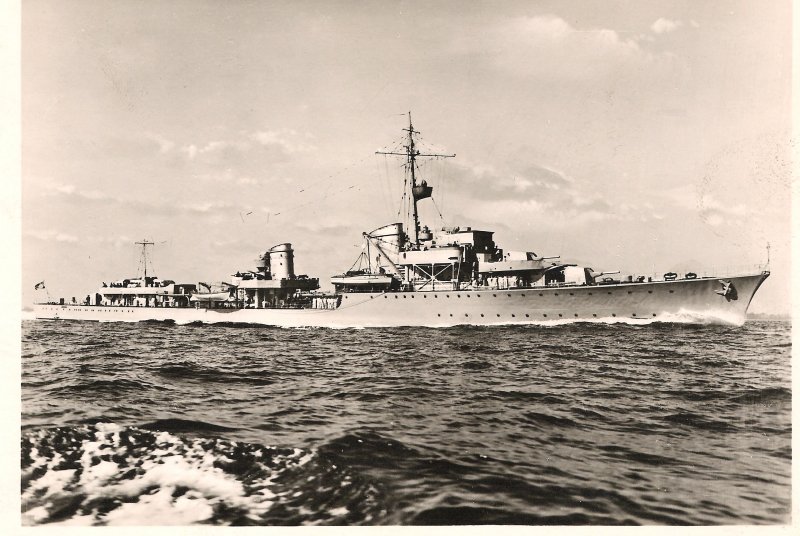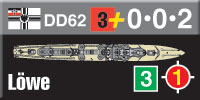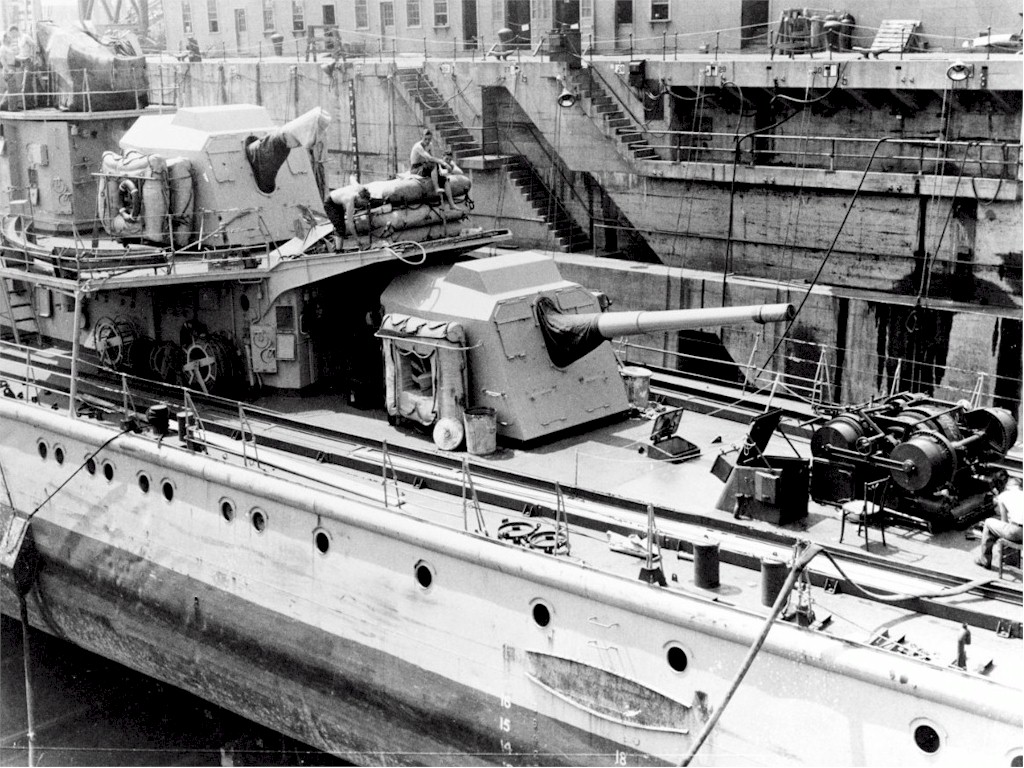The Cruel Sea:
German Destroyers, Part Two
by Mike Bennighof, Ph.D.
January 2023
 The Second Great War is our alternative-history take on a world-wide conflict erupting in 1940. A peaceful end to the First Great War in late 1916 has allowed the old empires to survive, but it hasn’t eliminated the root causes of international strife. The Second Great War is our alternative-history take on a world-wide conflict erupting in 1940. A peaceful end to the First Great War in late 1916 has allowed the old empires to survive, but it hasn’t eliminated the root causes of international strife.
Re-writing the histories of the empires also meant re-writing the story of the ships they built to wage this new war. In designing the cardboard ships of the Imperial German Navy for our Second Great War at Sea: The Cruel Sea expansion set, I tried to follow the patterns shown by the naval architects who drafted the warships of both Imperial and Nazi Germany. In many categories these practices followed the same lines; the battleship Bismarck, most notably, is nothing more than a warmed-over version of late Imperial battleship projects.
The two services took radically different approaches to destroyer design. With some notable exceptions like the huge Type 1916 Torpedo Boat, the Imperial Navy preferred small destroyers. They remained torpedo boats in purpose as well as name; their small size both reduced manpower requirements and would hopefully assist them in delivery torpedo attacks against enemy warships.
Under the Nazi regime, the architects went for giant boats the size of small cruisers. German destroyers were often twice the size of their British counterparts, without offering significantly greater combat capability. Their high-pressure steam power plants represented cutting-edge technology, but broke down constantly, giving the destroyers staggeringly poor mission availability. They looked impressive, but were poor fighting units.

Impressive looks, poor performance. A Nazi German Type 1936 destroyer.
Naval writers of the early 20th century described warships as having “visible” and “invisible” qualities, a convention we’ve tried to follow in our Great War at Sea and Second World War at Sea game series. A ship’s visible qualities (the ones we put on the game pieces) would be their weaponry and speed. A ship’s invisible qualities (the ones we keep on the data sheets) would be protection and range, and also mechanical reliability. Thus the Nazi Kriegsmarine emphasized visible qualities to impress the nation’s leader, who knew little of naval affairs but imagined that he did. The Imperial Navy had to impress a leader who at least knew something of naval affairs but imagined that he knew a great deal more. And thus it could better afford to concentrate on invisible qualities.
I tried to blend those two paths for the Imperial German destroyers of The Cruel Sea. Their armament, size and machinery is in keeping with Imperial practice: conservative, for the most part, with a strong torpedo armament. They are fast, with somewhat limited range and like all destroyers, no armor protection. Their lines are taken from Nazi German destroyer designs, and they share the lack of a dual-purpose main armament.
 The Löwe-class boats are the Imperial equivalent (at least in terms of layout) of the Nazi Type 1942A destroyer, though considerably smaller. The Nazi boats, had they been completed, would have weighed in at about 2,800 tons’ displacement; the Imperial destroyer displaces about 1,800 tons. Like the preceding Hornisse class, themselves the Imperial equivalent of the Nazi Type 1934 destroyer, Löwe has a conventional set of boilers driving turbines, for a top speed of about 34 knots. The Type 1942 would have had a huge Diesel power plant for a theoretical speed of 37.5 knots, with a range allowing operations in the mid-Atlantic without re-fueling, as part of a diesel-powered battle group. The Löwe-class boats are the Imperial equivalent (at least in terms of layout) of the Nazi Type 1942A destroyer, though considerably smaller. The Nazi boats, had they been completed, would have weighed in at about 2,800 tons’ displacement; the Imperial destroyer displaces about 1,800 tons. Like the preceding Hornisse class, themselves the Imperial equivalent of the Nazi Type 1934 destroyer, Löwe has a conventional set of boilers driving turbines, for a top speed of about 34 knots. The Type 1942 would have had a huge Diesel power plant for a theoretical speed of 37.5 knots, with a range allowing operations in the mid-Atlantic without re-fueling, as part of a diesel-powered battle group.
In contrast, the Löwe-class boats are fleet destroyers, like those of other nations intended for a wide range of tasks including fleet defense, anti-submarine warfare and surface battle. Their improved hull design (shared with the Type 1942) would have made them less wet forward, allowing their weapons to operate in heavier seas than those of the preceding Hornisse class. They carry six 127mm SK C/34 guns in three twin gunhouses, two mounted forward and one aft. Like the Kriegsmarine, our alternative-history Imperial Navy lacks a dual-purpose weapon; without a serious threat of air attacks, there’s been no incentive to develop one.
They do carry a small array of lighter anti-aircraft weapons, but they’re maximized for surface combat, with two banks each of four torpedo tubes in early boats, two banks of three each in later units. They also have depth charge rails and throwers, and like all German destroyers of either regime, they’re fitted for minelaying.
The High Seas Fleet has 24 Löwe class destroyers, with 20 of them appearing in The Cruel Sea (the other four as assigned overseas). They form the backbone of the fleet’s destroyer force and as such see a great deal of action.
 For the next class, following the practice of both the Imperial Navy and the Kriegsmarine the main armament has shifted to the (relatively) big 150mm. The Crocodil class carries four of the KC/36 model, in the same layout as the Nazi Type 1936A destroyer (those not fitted with a dual gunhouse). For the next class, following the practice of both the Imperial Navy and the Kriegsmarine the main armament has shifted to the (relatively) big 150mm. The Crocodil class carries four of the KC/36 model, in the same layout as the Nazi Type 1936A destroyer (those not fitted with a dual gunhouse).
The Type 1936A was another huge destroyer, displacing 2,600 tons. The Crocodil class comes closer to its model than the previous destroyers described – those big guns and their mountings are much heavier than the usual destroyer armament – but still would only come in at about 2,000 tons. The Imperial version of the destroyer has conventional steam boilers and turbines, for a top speed of about 34 knots. Like Löwe, she has two banks each of three torpedo tubes, an array of light anti-aircraft weaponry and depth charge racks and throwers.
The 150mm gun had a two-piece round, and was heavier than one man could lift into the breach. Yet the weapon lacked a power assist, so several gunners had to manhandle each shell into the gun. That resulted in a terribly slow rate of fire, and later destroyer classes reverted to the smaller 127mm gun.

The aft 150mm guns of Nazi German destroyer Z39, seen postwar.
The Imperial Navy at one point seemingly learned its lesson with the huge Type 1916 torpedo boat, and in our alternative history those older boats have been re-fitted with smaller, easier to handle weapons. But bureaucracies tend to forget lessons learned, and a new generation of admirals and architects decided to try a bigger gun on their destroyers. The result is a boat that’s actually less capable in surface combat than the preceding class (the same problems the Kriegsmarine discovered). With no armor, and all of the stability problems of a destroyer in heavy seas, Crocodil and her sisters are little more than very small, ineffective cruisers.
The High Seas Fleet has a dozen Crocodil-class boats. Eight of them appear in The Cruel Sea, with the other four assigned to overseas stations. Less effective than other classes, they are deployed with the battle fleet nonetheless and are heavily involved in the action.
You can order The Cruel Sea right here, right now.
Sign up for our newsletter right here. Your info will never be sold or transferred; we'll just use it to update you on new games and new offers.
Mike Bennighof is president of Avalanche Press and holds a doctorate in history from Emory University. A Fulbright Scholar and NASA Journalist in Space finalist, he has published a great many books, games and articles on historical subjects; people are saying that some of them are actually good.
He lives in Birmingham, Alabama with his wife and three children. He will never forget his Iron Dog, Leopold. Leopold feared ocean waves.
Want to keep Daily Content free of third-party ads? You can send us some love (and cash) through this link right here.
|
